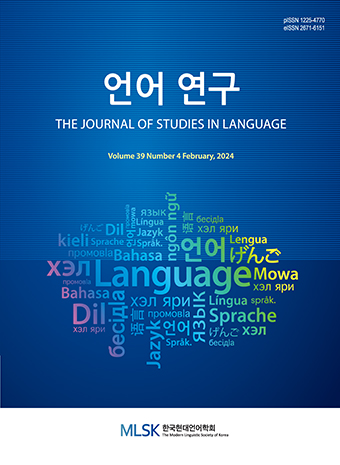Research Article
Abstract
References
Information
The purpose of this paper is to examine English [V NP into V-ing] constructions. This construction shares quite a few properties with causative sentences. For example, both are to express transitivity relationship such as [cause X to do Y] between the participants. However, corpus data suggest that this transitivity relationship may not be established in some cases (e.g., idiomatic expressions) simply because there is no X to be posited. As an alternative analysis, this paper proposes a resultative construction analysis. In this analysis, the participant X in the form of [cause X to do Y] does not pose any problem because what is important in this analysis is the end-point result. All cases of [V NP into V-ing] investigated in this paper fall out under the presented analysis.
- Carrier, J. and J. Randall. 1992. The Argument Structure and Syntactic Structure of Resultatives. Linguistic Inquiry 23.2, 173-234.
- Davies, M. 2013. Recent Shifts with Three Nonfinite Verbal Complements in English: Data from the 100 million word TIME Corpus (1920s-2000s). In B. Aarts, J. Close, G. Leech, and S. Wallis (eds.), The Verbal Phrase in English, Cambridge: Cambridge University Press, 46-67. 10.1017/CBO9781139060998.004 23376506
- Francis, G., H. Susan, and M. Elizabeth (eds). 1996. Collins Cobuild Grammar Patterns 1: Verbs. London: HarperCollins.
- Goldberg, A. 1995. Constructions: A Construction Grammar Approach to Argument Structure. Chicago: University of Chicago Press.
- Goldberg, A. 1997. Making One’s Way Through the Data. In M. Shibatani and S. Thompson (eds.), Grammatical Constructions: Their Form and Meaning. Oxford: Clarendon Press, 29-53.
- Goldberg, A. 2006. Constructions at Work: Constructionist Approaches in Context. New York: Oxford University Press.
- Goldberg, A. and R. Jackendoff. 2004. The English Resultative As a Family of Constructions. Language 80, 532-68. 10.1353/lan.2004.0129
- Hunston, S. and G. Francis. 2000. Pattern Grammar: A Corpus-driven Approach to the Lexical Grammar of English. Amsterdam: John Benjamins. 10.1075/scl.4
- Israel, M. 1996. The Way Constructions Grow. In A. Goldberg (ed.), Conceptual Structure, Discourse, and Language. Stanford: CSLI, 217-230.
- Kim, J. and M. Davies. 2015. The “into causative” Construction in English: A Construction-based Perspective. English Language & Linguistics 20.1, 55-83. 10.1017/S1360674315000271
- Rudanko, J. 2005. Lexico-grammatical Innovation in Current British and American English: A Case Study on the Transitive into -ing pattern with Evidence from the Bank of English Corpus. Studia Neophilologica 77, 171-87. 10.1080/00393270500384791
- Rudanko, J. 2006. Emergent Alternation in Complement Selection: The Spread of the Transitive into -ing Construction in British and American English. English Linguistics 34.4, 312-331. 10.1177/0075424206293600
- Rudanko, J. 2012. On the Profiles of to infinitives and to -ing complements at a Time of Grammatical Variation, with Evidence from Current American English. Selected Papers from UK-CLA Meetings, 262-276.
- Publisher :The Modern Linguistic Society of Korea
- Publisher(Ko) :한국현대언어학회
- Journal Title :The Journal of Studies in Language
- Journal Title(Ko) :언어연구
- Volume : 36
- No :4
- Pages :565-576
- DOI :https://doi.org/10.18627/jslg.36.4.202102.565




 The Journal of Studies in Language
The Journal of Studies in Language






